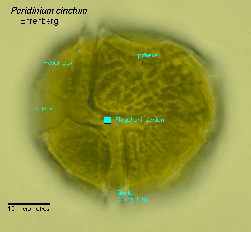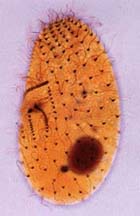




Protozoa are classified as Protists. The kingdom of the protists has become something of an anomaly in classification terms. It has ended up including protozoa, algae and all the organisms that do not fit into any other kingdom. However, there are certain common characteristics of Protists. First, they are all eukaryotes - unlike bacteria they have a distinct nucleus. Second, they may be unicellular or multicellular.



(Left) Peridinium Cinctum - a type of plankton found in the ocean Copyright © 1994-1999 by Charles J. O'Kelly and Tim
Littlejohn. University of Montreal
(Center) Ciliate soil protozoa eat tens of thousands of bacteria daily. © Wilhelm Foissner, Institute of Zoology, University of Salzburg
(Right) Ameba
They can exist as single-celled creatures, such as the rhizopods which include the famous ameba. The kingdom also includes creatures such as plankton, cilates, paramecia, oomycetes and algae. Most protists are microbial in size, but some types of algae can grow larger, typically to the size of a house-plant.
Oomycetes might be mistaken for fungi, for they are saprophytes and parasites. In general they live on and damage plants. They can be seen as a mildew on the surface of grapes, for instance. One species, Phytophthora infestans was responsible for the nineteenth century potato famine that occurred in Ireland.
Single-celled creatures such as ameba are often mistaken for animals but they are not, even though they exhibit animal-like behavior - movement for instance.
As with most other microorganisms, some protists - specifically protozoa and algae - can cause disease. However, unlike bacteria or viruses which operate at a cellular level, protozoa tend to behave as parasites. One of the diseases ameba cause is dysentery, which is common in tropical areas of the world including the tropical rainforest regions.
Other probably more fearsome diseases are also caused by protist parasites. These include Malaria , Sleeping Sickness (Trypanosomiasis), Leishmaniasis and Chagas disease. All these are associated with the rainforests of the world and are often spread by insect bites.
Locomotion
Protozoa have various mean of moving themselves around. Some use
flagella. Other, for instance
the cilates use cilia
which are tiny hairs that cover the entire outside surface (see image
central above). These can be made to beat in such a way that the
organism can be moved along in a particular direction. Ameba move
deforming their shape and reaching out with psuedopodia
(literally false legs), then dragging themselves along.
Protist Image Data
Animal web
Soil Protozoa
The Diptera (Flies) WHO Division of Control of Tropical Diseases - Malaria
Malaria - Effects
Go
to
Home
| Space Station
| Mars | Rainforest
© 1999 Satellite Events Enterprises Inc.